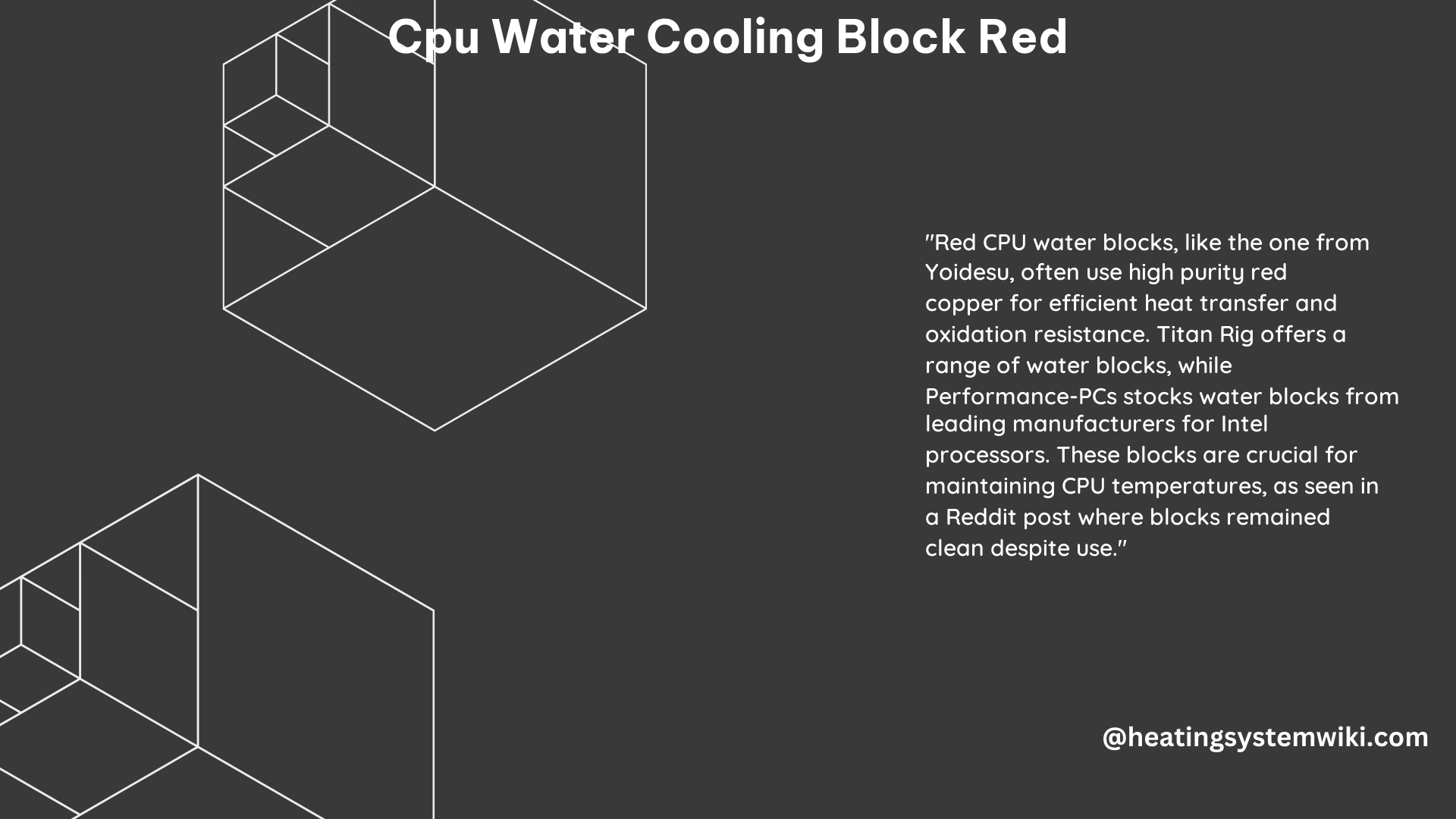The CPU water cooling block is a crucial component in a liquid cooling system for a computer, designed to efficiently transfer heat away from the CPU. When focusing on a red CPU water cooling block, there are several key features, technical specifications, and DIY aspects to consider for optimal performance and aesthetics.
Key Features and Technical Specifications
Material and Composition
The bottom of a high-quality red CPU water cooling block is typically made from pure copper, with a purity level of 99.9% or higher. This pure copper construction ensures efficient heat transfer and prevents oxidation, which can degrade the block’s performance over time. The top of the block is often made from transparent acrylic or tempered glass, allowing users to admire the vibrant red color of the copper.
Thickness and Dimensions
The thickness of a red CPU water cooling block is usually around 0.3mm, providing a balance between heat dissipation and structural integrity. This thin profile helps to minimize the overall height of the cooling system, allowing for better compatibility with various computer cases and other components. The dimensions of a typical red CPU water block range from 60mm x 60mm to 80mm x 80mm, with a height of approximately 20-30mm.
Compatibility and Mounting
Ensuring compatibility with your specific CPU socket is crucial when selecting a red CPU water cooling block. The most common socket types supported include Intel LGA 1151, 1155, 1156, 1366, 2011, and 2066, as well as AMD AM4, AM3+, and TR4. Many red water blocks come with the necessary mounting hardware, such as backplates and screws, to facilitate a secure and easy installation on your CPU.
Pressure Drop and Flow Rate
The pressure drop across the red CPU water cooling block is an important consideration, as it can impact the overall performance and flow rate of the cooling system. A lower pressure drop is generally desirable, as it allows for a higher flow rate and better heat dissipation. Manufacturers often provide the pressure drop specification, typically measured in millibars (mbar) or millimeters of water column (mmH2O), to help users assess the block’s performance.
Fin Design and Cooling Performance
The internal fin design of the red CPU water cooling block can significantly influence its cooling performance. A dense fin structure, with a high surface area-to-volume ratio, generally provides better heat dissipation. Some manufacturers may also incorporate advanced fin geometries, such as micro-fins or optimized flow channels, to further enhance the block’s cooling capabilities.
Coolant Compatibility
When using a red CPU water cooling block, it’s essential to ensure compatibility with the coolant you plan to use. While the block itself is typically made of copper, the presence of other materials, such as acrylic or nickel plating, may require specific coolant formulations to prevent corrosion or discoloration. It’s recommended to consult the manufacturer’s guidelines or seek advice from experienced water cooling enthusiasts to determine the best coolant for your red water block.
DIY Perspective

Assembling a custom liquid cooling system with a red CPU water cooling block can be a rewarding and visually striking experience for DIY enthusiasts. Here are some key steps to consider:
Research and Component Selection
Begin by thoroughly researching high-quality red CPU water cooling blocks from reputable manufacturers. Carefully evaluate the technical specifications, such as material, thickness, compatibility, pressure drop, and fin design, to ensure the block meets your cooling requirements and aesthetic preferences.
Planning the Cooling Loop
Plan the layout of your cooling loop, taking into account the path of the coolant, the number of components to be cooled (e.g., CPU, GPU, VRM), and the overall flow rate. Consider the placement of the red CPU water block, as well as any additional radiators, fans, and tubing required to complete the loop.
Installation and Thermal Paste Application
Carefully install the red CPU water cooling block onto your processor, ensuring a secure fit and proper thermal paste application. Follow the manufacturer’s instructions closely to avoid any installation issues or potential damage to your CPU or motherboard.
Leak Testing and Performance Monitoring
After assembling the cooling loop, conduct a thorough leak test to ensure the system is free of any potential leaks. Once the system is confirmed to be leak-free, monitor the CPU temperatures under various workloads to ensure the red water block is providing the expected cooling performance.
Coolant Maintenance and Aesthetic Customization
Regularly maintain the coolant in your system, checking for any discoloration or contamination that may affect the performance of the red CPU water cooling block. Additionally, you can explore various coolant color options, such as red or a combination of red and other colors, to further enhance the aesthetic appeal of your custom liquid cooling setup.
By following these steps and paying close attention to the technical details, DIY enthusiasts can successfully integrate a high-quality red CPU water cooling block into their custom liquid cooling systems, achieving both exceptional cooling performance and a visually striking appearance.
